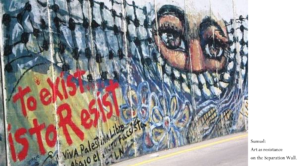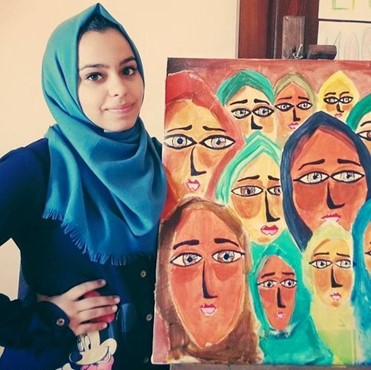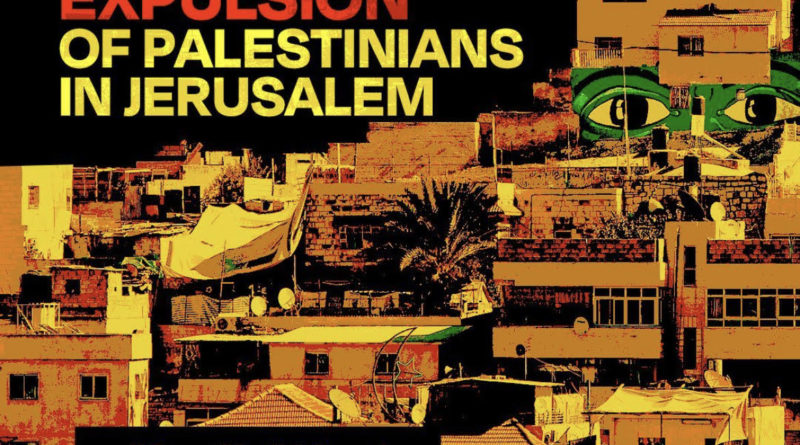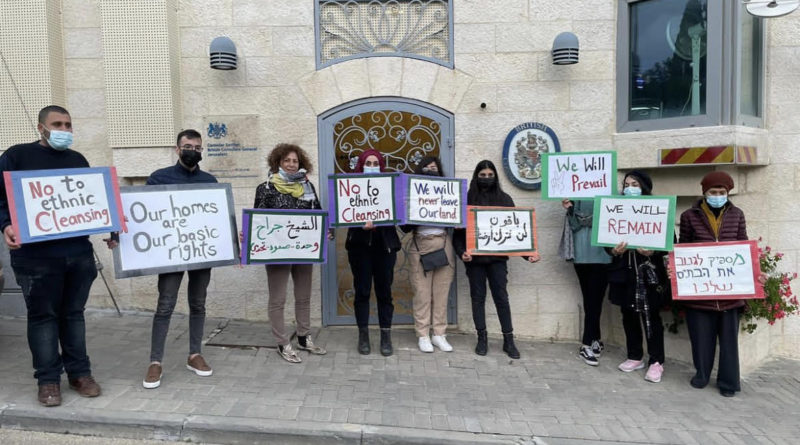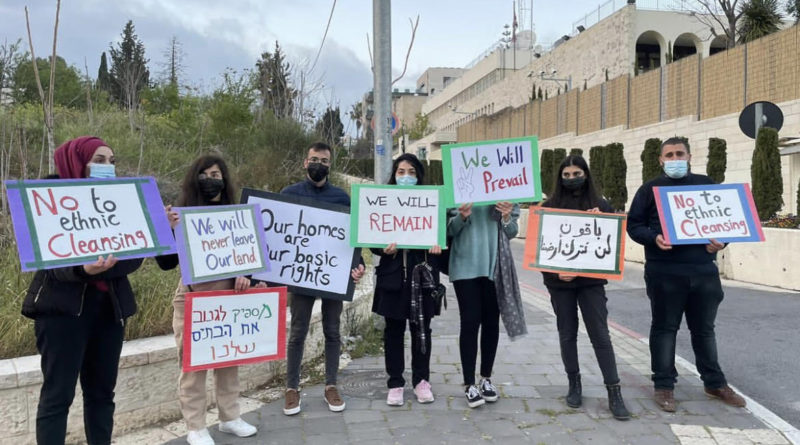Invisible Resistance: Sumud by Katherine Cunningham and Noushin Darya Framke
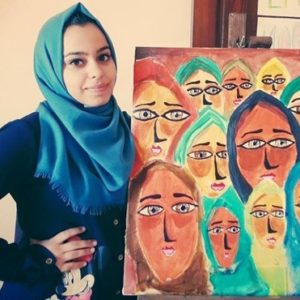 Who will separate us from the love of Christ? Will hardship, or distress, or persecution, or famine, or nakedness, or peril, or the sword?…For I am convinced that [nothing] in all creation will be able to separate us from the love of God. Romans 8: 35, 39 NRSV
Who will separate us from the love of Christ? Will hardship, or distress, or persecution, or famine, or nakedness, or peril, or the sword?…For I am convinced that [nothing] in all creation will be able to separate us from the love of God. Romans 8: 35, 39 NRSV
Palestinian Christians take this affirmation of hope from Romans 8, trusting the presence of the Holy Spirit:
From this vision derives the strength to be steadfast, remain firm and work to change the reality in which we find ourselves. Kairos Palestine, section 3.2
The demand for the right of return for refugees and the right of Palestinians to resist their occupation and subjugation are enshrined in international law, a fact that is denied and violated by Israel and willfully overlooked by the rest of the world, but Palestinians continue to resist and struggle against Israeli apartheid and erasure. Besides political resistance, after decades of political struggle for these rights, there has always been another quintessentially Palestinian way to resist: Sumud.
Sumud is an Arabic word with many layers of meaning, particularly applicable to Palestinian life. It embodies the lived experience of being steadfast in the face of struggle and even hopelessness. It is a steadfast hope. Sumud is resilience, which moved into popular practice after the Naksa, the 1967 war, that led to the now on-going annexation and occupation of Gaza, the West Bank and East Jerusalem. Sumud is the living spirit of the Palestinians who refuse to yield their land, their culture, their stories and their history, even in the face of erasure and ethnic cleansing by the State of Israel. Sumud is refusing to yield to colonialism and its policies created to drive Palestinians out of their own land.
Existence Is Resistance
Palestinians have learned through sumud —steadfastness— that existence is resistance. The decades-old military occupation, now complete with Kafka-esque checkpoints all over Palestine as portrayed in the Oscar-nominated 2021 short film, The Present, has taught Palestinians that enduring the abuses of the oppressor is a daily victory. Small daily victories add up to something big: remaining on the land and not being erased. Staying on the land and existing, keeps Palestinians and the struggle of memory alive.
Alain Epp Weaver of the Mennonite Central Committee, illustrates the importance of memory, especially in Palestine where he worked for many years:
Milan Kundera, in his novel, The Book of Laughter and Forgetting, writes that “the struggle of people against power is the struggle of memory against forgetting.” In contexts where the victors seek to erase the textual and material traces of the vanquished and to obscure the bloody means by which victory was obtained, acts of memory can become political acts, disturbing and challenging dominant narratives. Thus, when Palestinians make pilgrimage to the ruins of their ancestral homes in places such as Bir’am, Mujaydil, and Suhmata, walking around the remaining stones and narrating the life of the village and its destruction by the Israeli military, they re-create landscapes from which Palestinian presence has been removed, and name as a Nakba, or catastrophe, what prevailing Israeli narratives call redemption.
In Palestine, it is not just historians whose job it is to fight against forgetting. Not only do Palestinians try to keep the memories of ethnically cleansed villages alive, as described by Weaver, but they are also engaged in keeping the present alive. By living their daily lives under an oppressive military occupation under apartheid conditions, they keep their culture from being erased, despite the efforts of the Israeli colonizers to appropriate everything, down to even their foods. For this reason, expressing themselves through food, art, dance, music, embroidery, and other culture, Palestinians have turned these everyday acts into political acts of resistance.
Kathleen Christison, a political analyst, speaks about Palestinian resistance:
Palestine remains, in its people and their memory and, most notably, in their resistance to erasure. Resistance is a critical act of hope, the essence of that struggle of memory against forgetting. Resistance is the very embodiment of the struggle of memory—memory of what was, of what might yet be—against the efforts of Power to erase and forget. Resistance fueled by memory and hope is in fact the Palestinians’ only weapon in the struggle.… The mere act of resistance, even in the absence of a clear reason for hope, nurtures and builds hope, for without resistance there is only surrender. Without memory, there is only surrender.[1]
But sumud is a difficult and uphill struggle. Jonathan Cook, British journalist living in the Galilee area of Israel reports about daily erasure, using a term very specific to Israeli erasure of the native story and culture. He writes:
The Israeli historian Ilan Pappe has coined the term ‘memoricide’ for Israel’s erasure of most traces of the Palestinians’ past after it dispossessed them of four-fifths of their homeland in 1948, what Palestinians term their Nakba, or Catastrophe. Israel did more than just raze 500 Palestinian towns and villages. In their place it planted new Jewish communities with Hebraicised names intended to usurp the former Arabic names. Saffuriya became Tzipori; Hittin was supplanted by Hittim; Muyjadil was transformed into Migdal.
And the Judaization and erasure continues in the West Bank and East Jerusalem at breakneck pace today.
Being an ancient community, Palestinians have a rich culture of art, music, dance, literature, film, and more, that has sustained them through decades of attempts of erasure. They have a hospitality-centered culture of welcoming visitors and will open their homes to share their meals, which are from one of the finest food traditions, as they have been in the crossroads of many empires who have left their mark. There is a vibrant tradition of “tatreez”, a specifically Palestinian cross-stitch embroidery, which is kept alive by women’s cooperatives and passed on from mother to daughter. Tatreez patterns signify a particular village, and women in each village strive to make a “thobe” in their village’s traditional pattern, to wear on on their wedding and on special occasions.
Maintaining traditions such as tatreez, cooking their national dish, Maqluba, for large gatherings, and dancing the Dabka at all family events are all examples of “invisible resistance.” Culture and art are the heart of Palestinian sumud, showing that indeed, “to exist is to resist.” Mirna Bamieh, an artist and cook who is fighting the appropriation and disappearance of Palestinian cuisine, displays sumud in reviving old food practices and forgotten dishes. (Seen in video on sumud.)
[1] Why Palestine Matters: The Struggle to End Colonialism (The Israel Palestine Mission Network of the Presbyterian Church [U.S.A.], 2018)
